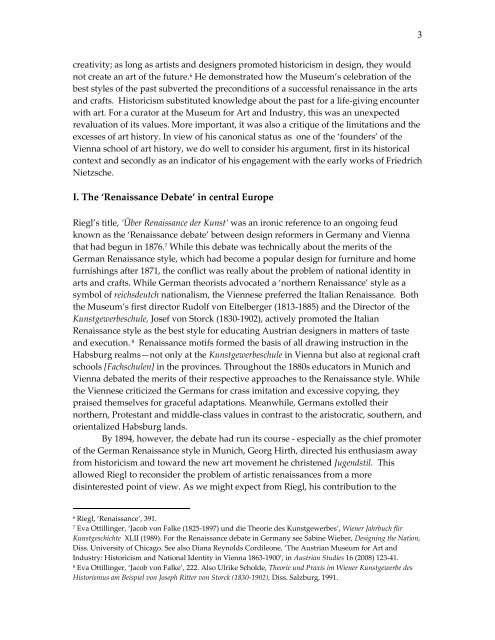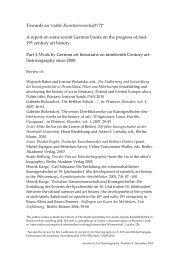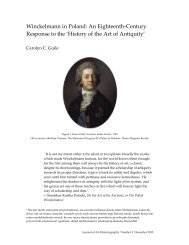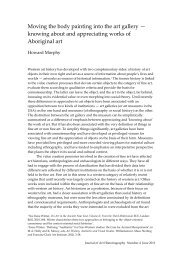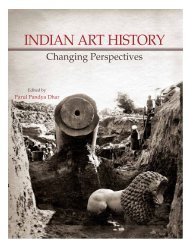The advantages and disadvantages of Art History to Life: Alois Riegl ...
The advantages and disadvantages of Art History to Life: Alois Riegl ...
The advantages and disadvantages of Art History to Life: Alois Riegl ...
You also want an ePaper? Increase the reach of your titles
YUMPU automatically turns print PDFs into web optimized ePapers that Google loves.
creativity; as long as artists <strong>and</strong> designers promoted his<strong>to</strong>ricism in design, they would<br />
not create an art <strong>of</strong> the future. 6 He demonstrated how the Museum’s celebration <strong>of</strong> the<br />
best styles <strong>of</strong> the past subverted the preconditions <strong>of</strong> a successful renaissance in the arts<br />
<strong>and</strong> crafts. His<strong>to</strong>ricism substituted knowledge about the past for a life-giving encounter<br />
with art. For a cura<strong>to</strong>r at the Museum for <strong>Art</strong> <strong>and</strong> Industry, this was an unexpected<br />
revaluation <strong>of</strong> its values. More important, it was also a critique <strong>of</strong> the limitations <strong>and</strong> the<br />
excesses <strong>of</strong> art his<strong>to</strong>ry. In view <strong>of</strong> his canonical status as one <strong>of</strong> the ‘founders’ <strong>of</strong> the<br />
Vienna school <strong>of</strong> art his<strong>to</strong>ry, we do well <strong>to</strong> consider his argument, first in its his<strong>to</strong>rical<br />
context <strong>and</strong> secondly as an indica<strong>to</strong>r <strong>of</strong> his engagement with the early works <strong>of</strong> Friedrich<br />
Nietzsche.<br />
I. <strong>The</strong> ‘Renaissance Debate’ in central Europe<br />
<strong>Riegl</strong>’s title, ‘Über Renaissance der Kunst’ was an ironic reference <strong>to</strong> an ongoing feud<br />
known as the ‘Renaissance debate’ between design reformers in Germany <strong>and</strong> Vienna<br />
that had begun in 1876. 7 While this debate was technically about the merits <strong>of</strong> the<br />
German Renaissance style, which had become a popular design for furniture <strong>and</strong> home<br />
furnishings after 1871, the conflict was really about the problem <strong>of</strong> national identity in<br />
arts <strong>and</strong> crafts. While German theorists advocated a ‘northern Renaissance’ style as a<br />
symbol <strong>of</strong> reichsdeutch nationalism, the Viennese preferred the Italian Renaissance. Both<br />
the Museum’s first direc<strong>to</strong>r Rudolf von Eitelberger (1813-1885) <strong>and</strong> the Direc<strong>to</strong>r <strong>of</strong> the<br />
Kunstgewerbeschule, Josef von S<strong>to</strong>rck (1830-1902), actively promoted the Italian<br />
Renaissance style as the best style for educating Austrian designers in matters <strong>of</strong> taste<br />
<strong>and</strong> execution. 8 Renaissance motifs formed the basis <strong>of</strong> all drawing instruction in the<br />
Habsburg realms—not only at the Kunstgewerbeschule in Vienna but also at regional craft<br />
schools [Fachschulen] in the provinces. Throughout the 1880s educa<strong>to</strong>rs in Munich <strong>and</strong><br />
Vienna debated the merits <strong>of</strong> their respective approaches <strong>to</strong> the Renaissance style. While<br />
the Viennese criticized the Germans for crass imitation <strong>and</strong> excessive copying, they<br />
praised themselves for graceful adaptations. Meanwhile, Germans ex<strong>to</strong>lled their<br />
northern, Protestant <strong>and</strong> middle-class values in contrast <strong>to</strong> the aris<strong>to</strong>cratic, southern, <strong>and</strong><br />
orientalized Habsburg l<strong>and</strong>s.<br />
By 1894, however, the debate had run its course - especially as the chief promoter<br />
<strong>of</strong> the German Renaissance style in Munich, Georg Hirth, directed his enthusiasm away<br />
from his<strong>to</strong>ricism <strong>and</strong> <strong>to</strong>ward the new art movement he christened Jugendstil. This<br />
allowed <strong>Riegl</strong> <strong>to</strong> reconsider the problem <strong>of</strong> artistic renaissances from a more<br />
disinterested point <strong>of</strong> view. As we might expect from <strong>Riegl</strong>, his contribution <strong>to</strong> the<br />
6 <strong>Riegl</strong>, ‘Renaissance’, 391.<br />
7 Eva Ottillinger, ‘Jacob von Falke (1825-1897) und die <strong>The</strong>orie des Kunstgewerbes’, Wiener Jahrbuch für<br />
Kunstgeschichte XLII (1989). For the Renaissance debate in Germany see Sabine Wieber, Designing the Nation,<br />
Diss. University <strong>of</strong> Chicago. See also Diana Reynolds Cordileone, ‘<strong>The</strong> Austrian Museum for <strong>Art</strong> <strong>and</strong><br />
Industry: His<strong>to</strong>ricism <strong>and</strong> National Identity in Vienna 1863-1900’, in Austrian Studies 16 (2008) 123-41.<br />
8 Eva Ottillinger, ‘Jacob von Falke’, 222. Also Ulrike Scholde, <strong>The</strong>orie und Praxis im Wiener Kunstgewerbe des<br />
His<strong>to</strong>rismus am Beispiel von Joseph Ritter von S<strong>to</strong>rck (1830-1902), Diss. Salzburg, 1991.<br />
3


